Me, Waking You Up At Two Am: Hey, Do You Ever Think About How We Live In A Culture Of Rejecting Our Local
Me, waking you up at two am: hey, do you ever think about how we live in a culture of rejecting our local “wild places” in favor of fetishizing and romanticizing the distant and different?
There’s this overwhelming rhetoric we’re fed that the only nature worth protecting is Grand and Huge and most of all Somewhere Else.
Nobody thinks about the wetland behind their local Walmart that is in Desperate need of protection, or the little remnant prairie in a cemetery, because they’re too focused on the abstract and often flawed concept of “wilderness” somewhere else.
There is nothing wrong with wanting to travel to see something new and unique, but the way I hear people talk about our own backyard, the way the last remnants of what we have here are ignored or outright rejected, breaks my heart.
My professor has spent his entire career in the Midwest trying to protect wetlands from housing developments and new superstores, but he almsot always loses, not just because the developers have money, but the community doesn’t care enough to do anything about it.
Afterall, what’s a few old oak and birch trees in a little puddle of a swamp compared to miles of marsh in Scandinavia? What’s a grassy hill to a distant mountain range?
Well, to the duck, to the heron, to the bluebird, and to precious few people, I’d say it’s Everything.
I love to travel myself, and I know people probably don’t know that when they say “why is our wildlife/plant life etc. so lame” that they’re contributing to an attitude of rejecting what unique beauty we do have,
But
I hope one day people can see the wonder nearby and fight to protect it. I hope there’s something left to protect.
Anyway…..where do u keep your cups I want some water.
More Posts from Green-notebooks and Others




Plant Cuttings!
Most plants can be grown from cuttings meaning that, if you know what you’re doing, they’re a great way to rapidly grow a whole garden full of plants. Or a whole house full, if you’d prefer.
The simplest type are stem cuttings, but many plants can be regrown from other parts like leaves or roots too. As long as there are stem cells in the cutting it’s possible to, with some care, regrow a full plant. In practice, how easy this is depends on the specific plant – but it never hurts to try!
So here are a bunch of how-to resources for anyone who wants to know more.
Basic how-to guide
More basic info
Detailed advice
Taking summer cuttings
Taking root cuttings
Taking leaf cuttings
Taking tip cuttings
Taking hardwood cuttings
Using potatoes to grow cuttings
Some plants which grow well from stem cuttings
Here are some random ideas of things to do with cuttings…
Buy a rose bush. The good ones like damask roses can be expensive, but that’s ok. Prune it extensively and plant the stems as cuttings. You’ll soon have a whole host of rose bushes! The same thing goes for any other bush or tree. Plant yourself an apple orchard or a raspberry grove!
Buy fresh herbs. Cook with the leaves. Save aside the stems. Grow them as cuttings. Create a herb garden in your windowsill.
Going out for a walk? Carry a small jar in your bag with some damp tissue in the bottom, and a small pair of study scissors. If you see any wild plants or trees you like the look of, snip off a small stem (from somewhere discrete!) and keep it in the jar. Grow it as a cutting when you get home. (Note: I’d advise against doing this in gardens, parks, or other privately owned areas. Technically, that’s theft.)
Grow kitchen scraps.
When you buy potatoes, check them for sprouts. Sprouting potatoes can be cut up into pieces, so each piece has at least one sprout or eye. Leave them overnight to dry off a little, then plant them. Soon you’ll have a whole potato patch. Just like Mark Watney.
If a friend has an interesting plant in their garden/home/office/wherever, ask them if you can take a small cutting. Most people won’t mind.
If there are trees or shrubs in your garden, you’ll probably need to prune them occasionally. Grow the pruned stems and branches as hardwood cuttings. If you don’t have space for more trees in your garden, they make good gifts once they’re established.
“Social Ecology: The notion that man must dominate nature emerges directly from the domination of man by man… But it was not until organic community relations… dissolved into market relationships that the planet itself was reduced to a resource for exploitation. This centuries-long tendency finds its most exacerbating development in modern capitalism. Owing to its inherently competitive nature, bourgeois society not only pits humans against each other, it also pits the mass of humanity against the natural world. Just as men are converted into commodities, so every aspect of nature is converted into a commodity, a resource to be manufactured and merchandised wantonly … The plundering of the human spirit by the market place is paralleled by the plundering of the earth by capital.”
— Murray Bookchin, Post-Scarcity Anarchism (via milkboydotnet)
do you know what I want? I want a game where you play the forces of overgrowing nature, where you systematically destroy the mansion in the GardenScapes game I keep seeing ads for.
like. let me grow grass up through those perfect tiled patios and algae in the fountain and vines up through those marble statues and pillars cracking them in half. let me plant wildflowers and berries and lure birds and butterflies into the yard.
let me grow trees up through the roofs and on top of those perfect stone walls and crack them and break them down
I will DESTROY IT. WITH NATURE.
no microtransactions, no timed building.
you plant seeds and wait for them to grow, then train them over the top of the walls and wrap around the statues
attract birds and squirrels with water and nesting areas and they’ll bring you seeds
the goal of the game is to get it so quiet and wild that you can support entire ecosystems in what used to be a super colonial classist mansion
the hardest thing in the and is to lure and be able to support a cougar, because it requires the entire property to be FOREST with deer and berry bushes and a stream
there’s also a hidden plot about the rest of the world
it’s the end of oil and the entire world has actually managed to switch over to clean energy, everyone lives in gorgeous green cities and close-knit small towns with super efficient greenhouse agriculture with solar and wind power
all the suburbs and manor-house things have been abandoned because they’re too far away from population centres and there aren’t any cars
there are electric public rail systems in all the cities and between population centres and most people bike and use hover-board drones for transportation
full-on solarpunk
you find this out because there’s a subplot of finding and repairing an iPhone with bits of tech you find in the rubble of the manor house, which you can then access a couple news sites on
but that’s kinda the hidden ending
there are a couple more things like that as well, hidden, like the story of the family who lived in the manor (they were all dicks and economically terrible people which adds even more catharsis to the destruction), some campers that come through if you fit a requirement for scenery, that kind of thing)
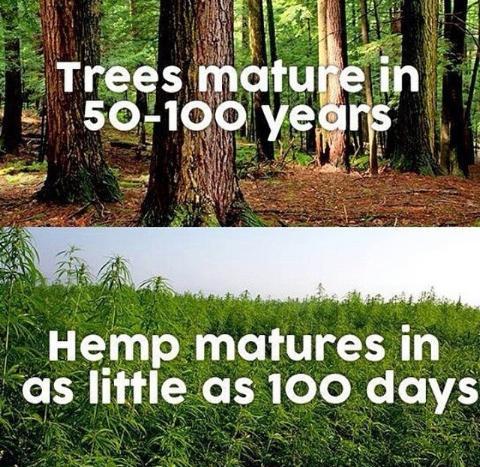
#SaveTheTrees

Italy’s Epic Treehouse Apartments Fulfill Everyone’s Childhood Dreams
Can't afford to buy things for your garden?
*Re-posting, with new information
A store-bought bag of topsoil, a roll of landscaping fabric, or a bag of cedar chips doesn’t go very far if you have a large garden or a very limited budget. Here are some ways to create the materials you need for a beautiful, organic, productive garden, by both re-directing household waste, and foraging in your local area. I use a lot of these tricks in my garden to make it almost completely free for me to continue growing new things, and expanding the workable area every year!
For soil
Save your food scraps to create a rich compost for growing veggies and amending your soil. There are numerous options for every size of dwelling and yard. Small space solutions such as Bokashi and vermicompost work indoors and don’t produce bad smells, so you can keep them underneath the sink.Worm towers, compost heaps, and outdoor compost bins are a great solution if you have more space. The more you add, the more rich, nutritious material you can make for your garden. I like composting because it means I don’t have gross smelly garbage bags to deal with, because food waste is diverted. It seems like a lot of work at first, but it actually saves time, money, and transportation.
Seaweed or kelp is one of the best things for your garden, with over 70 essential nutrients, and acting as a weed barrier and a moisture-retentive mulch. I collect seaweed nearby on the beach with my bike trailer, or, when I go for a walk I bring a little home with me each time. It’s an absolute miracle for your soil.

Worm tower
Fertiliser
There are three things that are essential for plant growth. These are nitrogen for leaves and vegetation (N), phosphorus for roots and shoots (P), and potassium for water movement, flowering, and fruiting (K). Commercial fertilisers will give the relative concentrations of each of these compounds with and “NPK” rating. Plants like tomatoes also need calcium to produce healthy fruit. You can create amendments for your garden and soil at home so that you do not have to purchase fertiliser.
For nitrogen
Grass clippings contain 4% nitrogen, 1% phosphorus, and 2% potassium (NPK = 4-1-2).
Human urine contains 12% nitrogen, and it’s sterile. Dilute before adding directly to plants.
Legumes such as beans, clover, peanuts, and alfalfa fix inorganic nitrogen into the soil with mycorrhizal organisms and nodules on their root systems. Plant these crops every few years in rotation with others to renew the soil organically.
For phosphorus
Human urine is also a great source of phosphorous and trace amounts of potassium.
Ground up bones or shells add a slow-release phosphorous to the soil
Had a baby recently? Bury the placenta in the garden.
For potassium
Hardwood ashes
Composted banana peels
For calcium
Break down all of your eggshells, or seashells you have found, in a plastic bucket, using vinegar. This creates a soluble calcium solution you can add to a watering can.
Soil Acidity/Alkalinity
Many plants are particular about what the soil pH should be.
To make soil more acidic: add oak leaves, pine needles, leaf mulch, urine, coffee grounds or sphagnum.
To make soil more alkaline: add wood ash, shell, or bone.
Mulch
Mulch is decomposing organic matter that adds nutrition to the soil, while simultaneously keeping out weed growth and retaining moisture. It also attracts worms, fungi and other beneficial creatures to your soil. Free sources of mulch include:
Leaves
Garden waste
Grass clippings
Straw (often straw bales are given away after being used for decoration in the fall. You can also plant vegetables directly in straw bales using a technique called straw bale gardening).
Wood chips (if you can borrow a wood chipper after you’ve collected some wood you can have attractive wood mulch for free)

Straw bale garden
Landscaping fabric
When mulch isn’t enough to keep the weeds down, many people opt for landscaping fabric. It can be quite expensive and inorganic-looking. Free solutions that both attract worms and can be replaced in small segments as they break down include:
Newspaper*
Cardboard*
Egg cartons*
Printer paper, looseleaf, etc. in thick layers*
*try to make sure you are using paper that has vegetable-based dyes, so you aren’t leeching toxins into the soil.
Soil density/drainage
If your soil is compacted and you have plants that require low levels of water, or excellent drainage, add sand. I don’t recommend stealing it from the beach, but ask around and you’d be surprised at how easy it is to get for free. Sawdust also improves drainage. Adding organic matter and mulch encourages worms, who also till and aerate compacted soil.
If the area still needs drainage, dig a hole and fill it with bricks or rocks to create a “dry well”
For drainage in pots, add crushed bricks, terra cotta pot fragments, packing peanuts, small stones, marbles, orsand to the bottom under the soil layer. I find these in construction sites, on craigslist, or at flea markets.
Pots and growing containers
If you have space, raised beds are a great no-dig way to establish growing space. If you are pressed for space (like working on a balcony) there are many cheap or free options for container gardens.
Creating raised beds allows you to build up the soil without digging. Free ways to do this include using rocks or lumber (like my DIY “lasagna garden” made with the sheet composting technique), using the “wattle“ method with sticks and posts you have found, using discarded straw bales, old bricks,paving stones, cinder blocks or really anything else you have lying around.
Hugelkutur raised beds, which fix carbon and provide drainage, can be made by stacking sticks and untreated wood, and then piling soil or compost over it. (Thanks milos-garden)
Rubber tire gardens retain heat in the night and allow for great drainage. They can also be painted in fun ways.
Herb spirals (here is mine: 1, 2, 3) can be built with stones, bricks, and other found materials.
I often use old cooking pots, barbecues, teapots, or other found objects as planters.
Making wooden planters is easy, and scrap or salvaged wood is also easy to come by. I’m not a fan of using wooden pallets for DIY projects, but they are also a free source of lumber for things like planters.
If you can track down peat moss, cement, and vermiculite, you can make an easy Hypertufa planter in whatever shape you would like, provided you have a form in which it can dry.
I’ve made hanging gardens out of soda cans.
You can build a self-watering container with a 2L pop bottle.
Start seeds in eggshells
Make biodegradable pots out of newspapers.
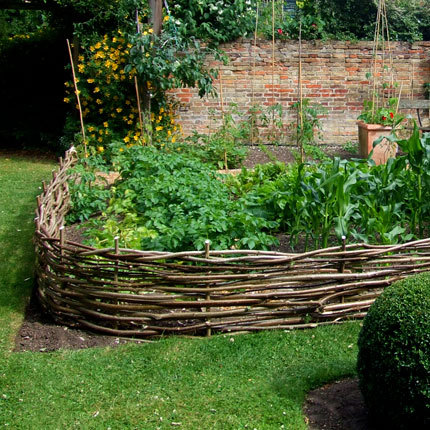
Wattle raised beds

Rubber tire gardens

Hugelkultur

An herb spiral
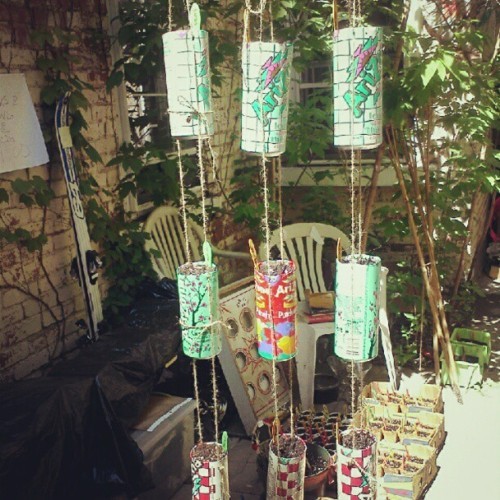
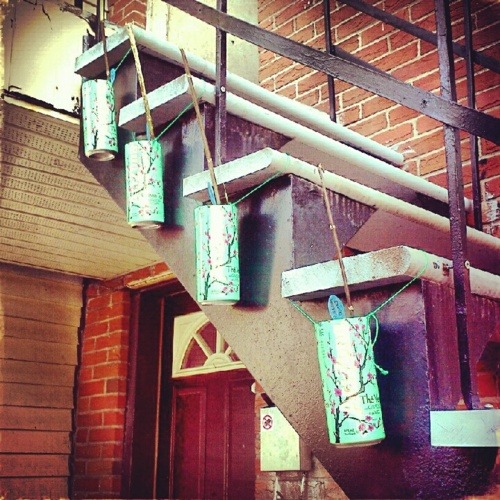
Hanging gardens in cans (2)
Trellises and supports
Many plants need external support, such as stakes of trellises, to thrive.
Rebar can almost always be salvaged cheaply or free and makes a great trellis, arch, or purgola
Build trellises and supports out of the pliable young stems of plants like willow
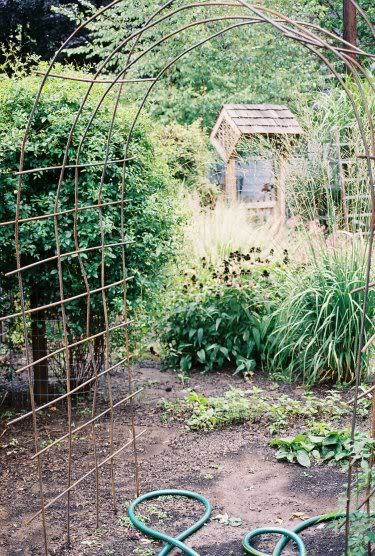
Rebar trellis/arch

Living willow arch/trellis
Paving
Paving often requires a foundation of sand or another stable and well-drained substrate, and a covering of stones, bricks, or other weatherproof elements. Slowly collect stones over time, or free paving stone fragments to create a mosaic-type walkway. Often people give these things away on craigslist. I made a patio and fireplace out of free salvaged bricks, for example.

Salvaged garden walkway
Greenhouses and cold frames
Here is a gallery of greenhouses made out of salvaged windows and doors
A cold frame is easy to make with salvaged lumber, and plastic sheeting.
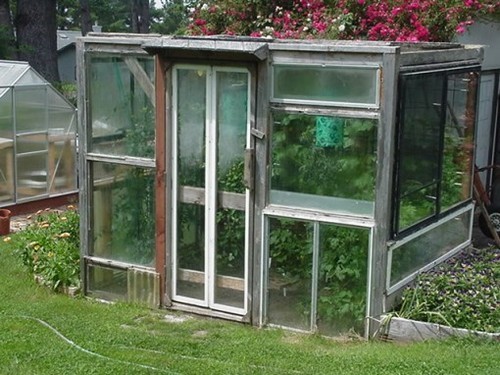
Window greenhouse
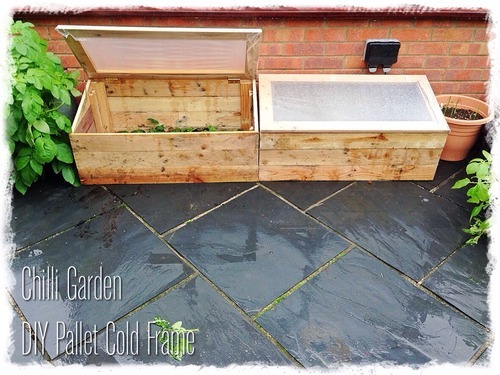
Palet cold-frame
Seeds and plants
Swap seeds with other gardeners
If you see a plant you like at someone’s house, ask for seeds or cuttings
Save seeds every year and build a library of options. Here is a great guide to seed saving.
Save seeds from foods you like from the grocery store: consider growing peanuts, ginger, garlic, peppers, or a walnut tree: all of these and more can be planted from store-bought produce.
Learn to take cuttings. There is a tonne of info on the web about basic cutting propagation, layering, (like I do with rhododendrons) air layering, and numerous other techniques to take clones of plants you like. This saves going to a nursery and shelling out big bucks for all the variety you want.
For cuttings, willow tea and honey are great rooting hormones/antiseptics/anti-fungal agents, which can save you $40 if you were thinking of buying commercial rooting hormone.
You can root cuttings in a potato! (See my methods for rooting “borrowed” plants here)
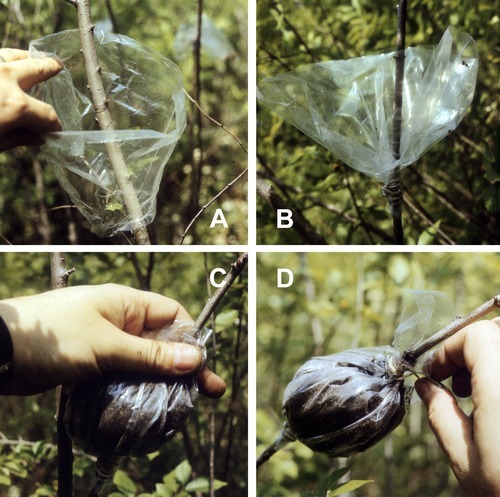
Air layering
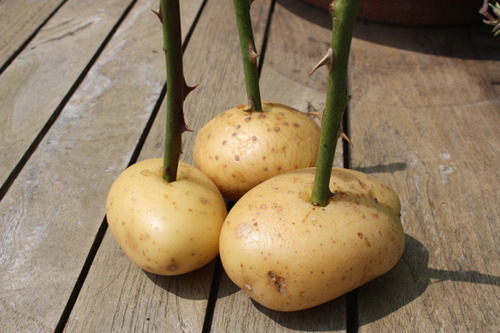
Rooting cuttings in potatoes
—-
I hope this helps you build your garden outside of the usual capitalist channels! It can be a cheap or free hobby if you are willing to think outside the box, and maybe put up with things that don’t look as clean or crisp as a hardware store catalogue. If you have any further ideas, please add them! The more information the better.

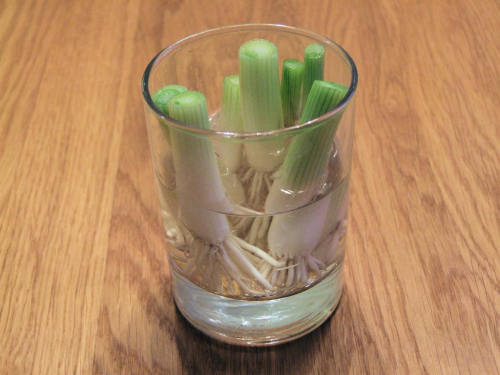
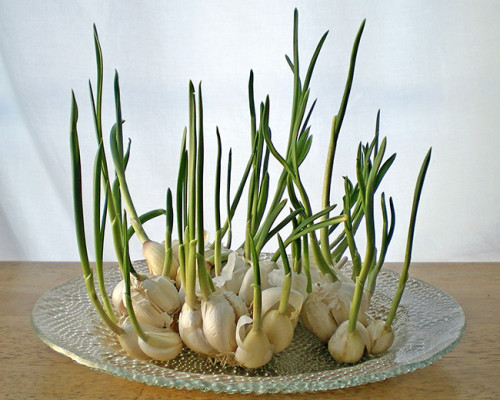
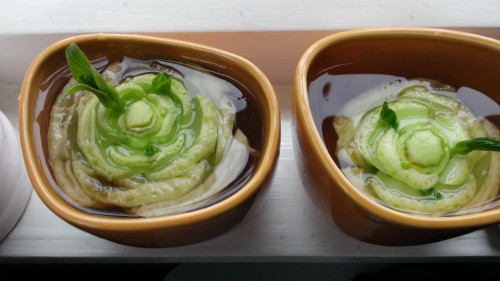
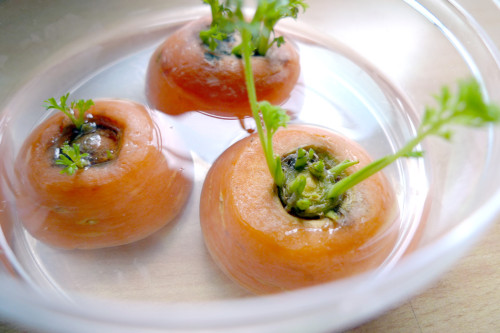
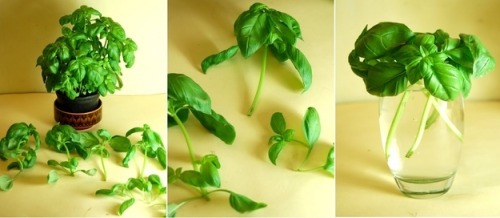

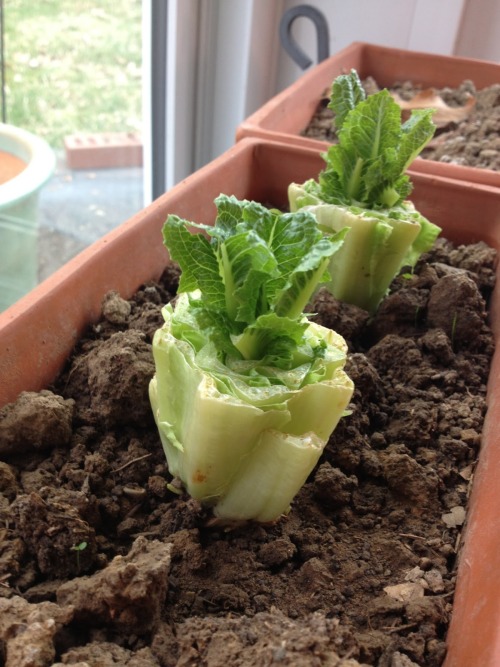
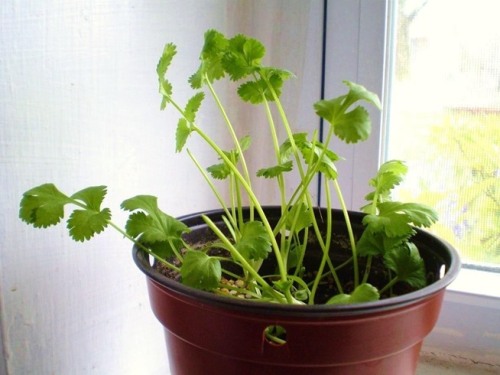
8 vegetables that you can regrow again and again.
Scallions
You can regrow scallions by leaving an inch attached to the roots and place them in a small glass with a little water in a well-lit room.
Garlic
When garlic begins to sprout, you can put them in a glass with a little water and grow garlic sprouts. The sprouts have a mild flavor than garlic and can be added to salads, pasta and other dishes.
Bok Choy
Bok choy can be regrown by placing the root end in water in a well-lit area. In 1-2 weeks , you can transplant it to a pot with soil and grow a full new head.
Carrots
Put carrot tops in a dish with a little water. Set the dish in a well-lit room or a window sill. You’ll have carrot tops to use in salads.
Basil
Put clippings from basil with 3 to 4-inch stems in a glass of water and place it in direct sunlight. When the roots are about 2 inches long, plant them in pots to and in time it will grow a full basil plant.
Celery
Cut off the base of the celery and place it in a saucer or shallow bowl of warm water in the sun. Leaves will begin to thicken and grow in the middle of the base, then transfer the celery to soil.
Romaine Lettuce
Put romaine lettuce stumps in a ½ inch of water. Re-water to keep water level at ½ inch. After a few days, roots and new leaves will appear and you can transplant it into soil.
Cilantro
The stems of cilantro will grown when placed in a glass of water. Once the roots are long enough, plant them in a pot in a well-lit room. You will have a full plant in a few months.





People on here should know about the mutual aid app! It’s really growing in the Chicago area (created by some college students from the suburbs), and it’s also being used in ABQ, parts of Colorado, and in the Navajo Nation! Sign up folks in your area and start growing your network!
california anti-drought measures are always like “take shorter showers! consider brushing your teeth with the sink turned off” and never mention the fact that nestle is bottling all of our fucking water and selling it to people who live in areas with plenty of water
-
 darkempressrising liked this · 6 months ago
darkempressrising liked this · 6 months ago -
 broniceprimordialpouch liked this · 7 months ago
broniceprimordialpouch liked this · 7 months ago -
 pikolswonderland reblogged this · 9 months ago
pikolswonderland reblogged this · 9 months ago -
 sciencesara liked this · 10 months ago
sciencesara liked this · 10 months ago -
 pakiztani liked this · 11 months ago
pakiztani liked this · 11 months ago -
 geniewithwifi liked this · 1 year ago
geniewithwifi liked this · 1 year ago -
 bewarethesnallygaster liked this · 1 year ago
bewarethesnallygaster liked this · 1 year ago -
 nonbinarynightmare77 reblogged this · 1 year ago
nonbinarynightmare77 reblogged this · 1 year ago -
 phantom-of-the-north reblogged this · 1 year ago
phantom-of-the-north reblogged this · 1 year ago -
 fomikrai liked this · 2 years ago
fomikrai liked this · 2 years ago -
 fantasymusic liked this · 2 years ago
fantasymusic liked this · 2 years ago -
 foxxyshmoxxy liked this · 2 years ago
foxxyshmoxxy liked this · 2 years ago -
 maracuyaas liked this · 2 years ago
maracuyaas liked this · 2 years ago -
 just-a-messy-soul reblogged this · 2 years ago
just-a-messy-soul reblogged this · 2 years ago -
 madaeleine liked this · 2 years ago
madaeleine liked this · 2 years ago -
 amilkyway liked this · 2 years ago
amilkyway liked this · 2 years ago -
 sludgecoveredpeasant liked this · 2 years ago
sludgecoveredpeasant liked this · 2 years ago -
 laplagesauvage reblogged this · 2 years ago
laplagesauvage reblogged this · 2 years ago -
 life-of-ice reblogged this · 2 years ago
life-of-ice reblogged this · 2 years ago -
 life-of-ice liked this · 2 years ago
life-of-ice liked this · 2 years ago -
 alice-blogs-things liked this · 2 years ago
alice-blogs-things liked this · 2 years ago -
 crwatters reblogged this · 2 years ago
crwatters reblogged this · 2 years ago -
 crwatters liked this · 2 years ago
crwatters liked this · 2 years ago -
 rheinmaedchen reblogged this · 2 years ago
rheinmaedchen reblogged this · 2 years ago -
 astravis liked this · 2 years ago
astravis liked this · 2 years ago -
 infernalscreeching liked this · 2 years ago
infernalscreeching liked this · 2 years ago -
 taking-the-time-to-do-this reblogged this · 2 years ago
taking-the-time-to-do-this reblogged this · 2 years ago -
 decadentbatbagelscissors liked this · 2 years ago
decadentbatbagelscissors liked this · 2 years ago -
 farjadedragon reblogged this · 2 years ago
farjadedragon reblogged this · 2 years ago -
 potorgaret--inactive liked this · 2 years ago
potorgaret--inactive liked this · 2 years ago -
 restlesspumpkin reblogged this · 2 years ago
restlesspumpkin reblogged this · 2 years ago -
 remediesforroses liked this · 3 years ago
remediesforroses liked this · 3 years ago -
 hoursofreading reblogged this · 3 years ago
hoursofreading reblogged this · 3 years ago -
 hoursofreading liked this · 3 years ago
hoursofreading liked this · 3 years ago -
 mihidesuntverba liked this · 3 years ago
mihidesuntverba liked this · 3 years ago -
 sunny-fog liked this · 3 years ago
sunny-fog liked this · 3 years ago -
 inkprincesse reblogged this · 3 years ago
inkprincesse reblogged this · 3 years ago -
 chocolatefker reblogged this · 3 years ago
chocolatefker reblogged this · 3 years ago -
 chocolatefker liked this · 3 years ago
chocolatefker liked this · 3 years ago -
 abananasaurus liked this · 3 years ago
abananasaurus liked this · 3 years ago -
 aetheriumcrystals liked this · 3 years ago
aetheriumcrystals liked this · 3 years ago -
 lotsofsodalove liked this · 3 years ago
lotsofsodalove liked this · 3 years ago -
 halfwaysleeping liked this · 3 years ago
halfwaysleeping liked this · 3 years ago